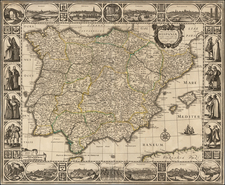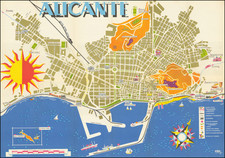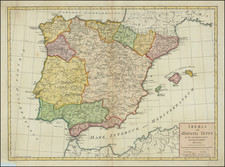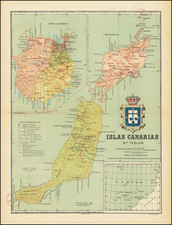Fine example of Braun & Hogenberg's view of the Escorial, the Royal Palace of Phillip II, King of Spain, from Braun & Hogenberg's Civitas Orbis Terrarum.
Finely engraved view of the palace of San Lorenzo de El Escorial. Constructed in 1563-1584 by the Spanish king Philip II, the monastery and palace form a magnificent royal residence. It is a manifestation of the desire to combine the royal court with monkish life. The basilica that rises up in the middle forms a link between the spiritual wing on the right, with cloister and monastery, and the worldly wing on the left, with the palace rooms and the famous art gallery. The private apartments of the king lay directly behind tha apse of the basilica (hidden by the tower). At times a world empire was ruled from the Escorial, and it remained the residence of the kings of Spain up to 1861.
The translation of the text on the verso reads:
This building, which is almost unique in the whole world, is a monastery inhabited by Hieronymite monks, as well as a royal palace and a hunting lodge, so delightful and beautiful that it is not inferior to the Seven Wonders of the Ancient World. The monastery's finest gable is on the west side, where it has three gates or doors, of which the middle one is the finest and gives access to the church, the convent and the chapter.
Georg Braun (1541-1622) was born and died in Cologne. His primary vocation was as Catholic cleric; he spent thirty-seven years as canon and dean at the church St. Maria ad Gradus, in Cologne. Braun was the chief editor of the Civitates orbis terrarum, the greatest book of town views ever published. His job entailed hiring artists, acquiring source material for the maps and views, and writing the text. In this role, he was assisted by Abraham Ortelius. Braun lived into his 80s, and he was the only member of the original team to witness the publication of the sixth volume in 1617.
Frans Hogenberg (ca. 1540-ca. 1590) was a Flemish and German engraver and mapmaker who also painted. He was born in Mechelen, south of Antwerp, the son of wood engraver and etcher Nicolas Hogenberg. Together with his father, brother (Remigius), uncle, and cousins, Frans was one member of a prominent artistic family in the Netherlands.
During the 1550s, Frans worked in Antwerp with the famous mapmaker Abraham Ortelius. There, he engraved the maps for Ortelius’ groundbreaking first atlas, published in Antwerp in 1570, along with Johannes van Deotecum and Ambrosius and Ferdinand Arsenius. It is suspected he engraved the title page as well. Later, Ortelius supported Hogenberg with information for a different project, the Civitates orbis terrarium (edited by Georg Braun, engraved by Hogenberg, published in six volumes, Cologne, 1572-1617). Hogenberg engraved the majority of the work’s 546 prospects and views.
It is possible that Frans spent some time in England while fleeing from religious persecution, but he was living and working in Cologne by 1580. That is the city where he died around 1590. In addition to his maps, he is known for his historical allegories and portraits. His brother, Remigius, also went on to some fame as an engraver, and he died around the same time as his brother.









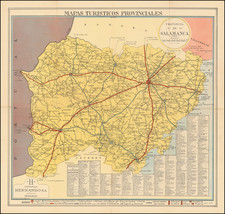
![[Basque Coast] Die Zee Custen van Biscaijen tuschen Laredo en Sentillana soe hem dat Selue landt all daer vertthoornt enn opdoet . . . 1583](https://storage.googleapis.com/raremaps/img/small/61468.jpg)
